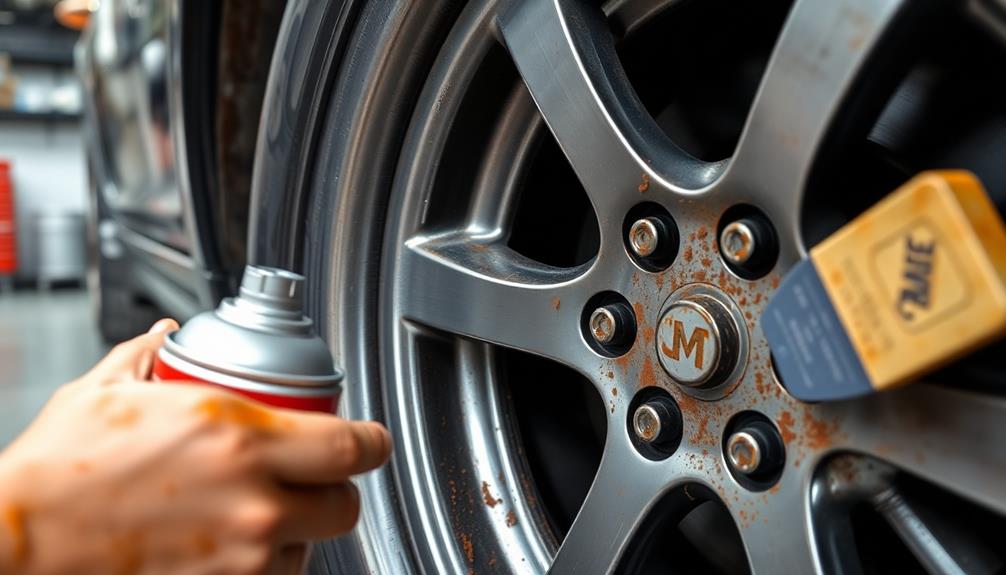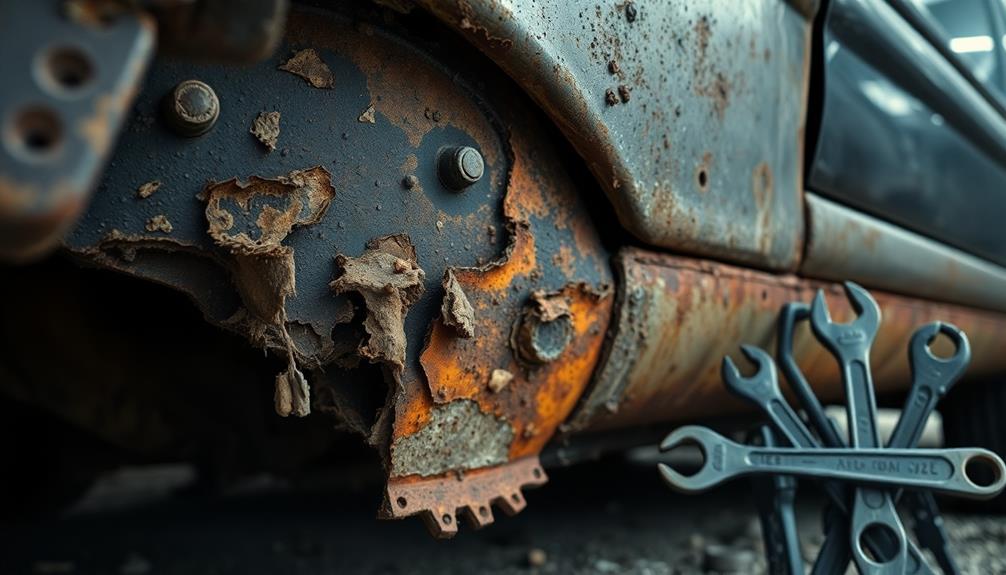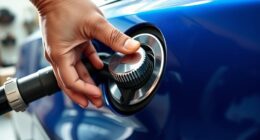The hidden danger in your car's frame can seriously affect your safety and performance. After even minor accidents, you might not notice issues like loose electrical connections or weakened suspension components. Signs of frame damage include uneven tire wear and misaligned doors, which you shouldn't ignore. If you overlook these, you risk escalating repairs and decreased vehicle value later on. Regular professional inspections are essential to catch these hidden issues before they become major problems. Understanding the full extent of frame damage is important for maintaining your car's integrity on the road, and there's much more to uncover about ensuring your vehicle's safety.
Key Takeaways
- Hidden frame damage can lead to severe safety risks and performance issues, often unnoticed after minor accidents.
- Common signs of frame damage include uneven tire wear and misaligned doors, indicating potential structural problems.
- Ignoring frame damage can escalate repair costs significantly, with misalignment and suspension repairs ranging from $1,000 to $4,000.
- Professional inspections are essential to detect hidden issues, as quick visual checks often overlook critical structural integrity evaluations.
- Regular maintenance and proactive driving habits can help prevent frame damage and enhance overall vehicle safety.
Understanding Car Frame Damage

Understanding car frame damage is important for every vehicle owner. This damage affects the structural components that support your vehicle, serving as its skeleton. Even minor accidents can lead to hidden structural issues that compromise your car's structural integrity.
You might notice signs like uneven tire wear or alignment problems, which could indicate frame damage that needs attention. After any collision, whether it's a fender bender or a more severe incident, a professional inspection is essential.
Many drivers overlook visible cosmetic damage, thinking their vehicle is fine, but underlying issues may lurk beneath the surface. Warping or bending of the frame can occur, leading to safety hazards that increase the risk of further accidents.
Ignoring these signs can result in more significant problems down the line, impacting your vehicle's performance and safety features. It's crucial to prioritize collision repair and have your car checked by a qualified technician.
Common Causes of Frame Damage
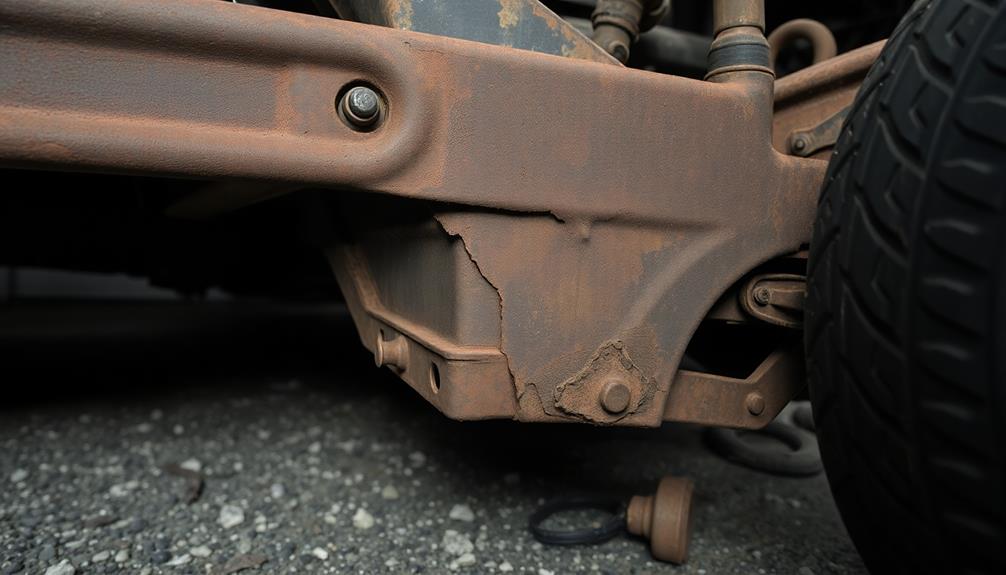
When you think about frame damage, it's easy to overlook the impact of minor accidents.
Even a small fender bender can cause hidden issues that compromise your car's structure.
Understanding how collision angles and speeds affect damage can help you stay aware and protect your vehicle.
Collision Impact Analysis
How does a seemingly minor accident lead to significant frame damage? Even fender benders can compromise your vehicle's structural integrity. The severity of frame damage often correlates with the angle and speed of the collision impact. Higher speeds and direct hits result in more substantial impairment.
Frame damage can manifest in various forms. Mash damage typically occurs from frontal or rear collisions, while sway damage arises from corner impacts, affecting vehicle alignment.
Unfortunately, hidden frame damage isn't always immediately visible. This is where professional inspections come into play. These thorough assessments can uncover issues like misalignment or twisted frames that may pose safety hazards while driving.
Ignoring these problems can lead to serious consequences, as a compromised frame increases the risk of severe safety hazards in future accidents. Timely repairs are vital; knowing your repair options can help you address frame damage effectively.
Regular inspections are essential to catch hidden issues early, ensuring your vehicle remains safe and roadworthy. Don't underestimate the impact of even minor collisions—understanding collision impact analysis can protect you and your passengers from unexpected dangers on the road.
Minor Accidents Considerations
Even a minor accident can catch you off guard, leading to unexpected frame damage that mightn't be immediately visible. You might think that a fender bender or low-speed collision won't cause any issues, but that's often far from the truth.
In commercial settings, just like vehicles, maintaining structural integrity is vital for safety and efficiency; importance of commercial grade heat pumps illustrates how essential it's to assess any potential damage.
Here are some common considerations regarding frame damage from minor accidents:
- Misalignment issues that cause your vehicle to pull to one side
- Uneven tire wear that can shorten the lifespan of your tires
- Hidden damages like loose electrical connections
- Compromised suspension components that affect safety
Even the slightest impact can compromise your vehicle's structural integrity, resulting in sway damage or minor bends. These issues may not show up until they escalate, creating significant safety hazards.
Regular inspections after any collision—no matter how minor—are important. They help identify and address potential frame damage before it leads to more serious problems.
Don't overlook the significance of checking for hidden damages; what seems like a small issue could lead to costly repairs and unsafe driving conditions down the line.
Make it a habit to verify your car's frame remains in top shape!
Signs of Hidden Frame Issues
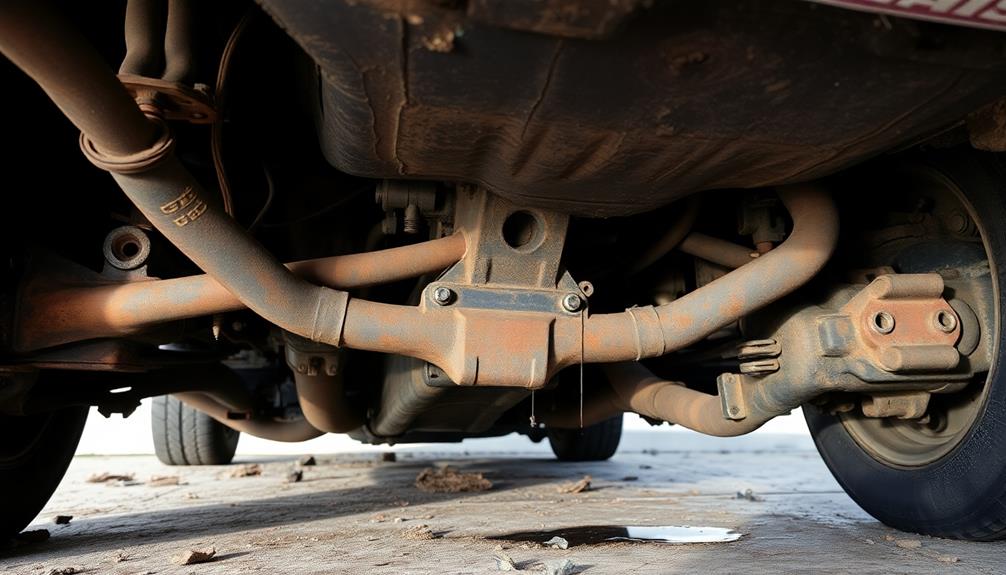
Misaligned doors and uneven gaps can be more than just unsightly; they often signal hidden frame issues that compromise your vehicle's structural integrity. If you're noticing these signs of frame damage, it's crucial to pay attention.
Uneven tire wear, especially on the inner edges, can indicate frame misalignment, suggesting deeper problems that mightn't be immediately visible.
You might also feel your vehicle pulling to one side or requiring extra effort to drive straight; these behaviors can signal underlying frame damage linked to alignment issues.
Additionally, strange noises—like rattles or squeaks—while driving could be a sign that frame damage is affecting your vehicle's suspension and overall stability.
If you're struggling to close doors, hoods, or trunks properly, this could point to warping or misalignment of the frame, indicating that it's time for a thorough inspection at your local auto body repair shop.
Ignoring these signs of hidden frame damage can lead to more serious problems down the road. Keeping an eye out for these indicators can help guarantee your vehicle remains safe and structurally sound.
Consequences of Ignoring Damage
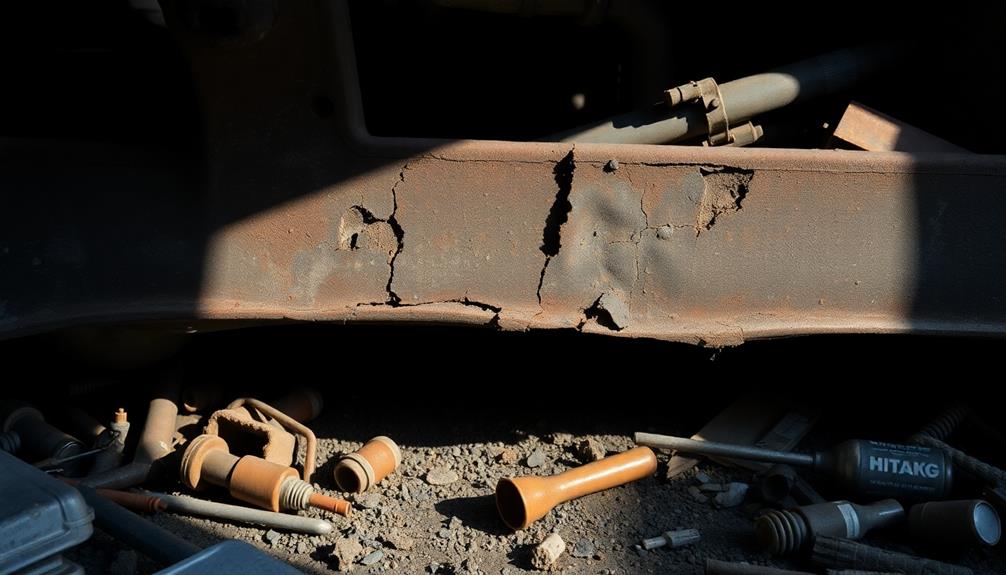
Ignoring frame damage can put your safety at serious risk, especially during a collision.
Additionally, neglecting repairs now may lead to costly issues down the line, as misalignment and electrical problems can escalate over time.
Don't wait until it's too late; addressing frame damage early can save you money and keep you safe on the road.
Safety Risks Increase
When you overlook frame damage in your vehicle, you're not just risking your car's performance; you're putting your safety on the line. Ignoring this issue can lead to serious consequences that affect how your vehicle handles and responds in critical situations.
- Increased risk of injury during collisions
- Unstable handling due to misalignment
- Malfunctioning brakes and steering systems
- Decreased resale value of your vehicle
Compromised vehicle integrity means your car mightn't absorb impact energy effectively, raising the risk of injury in future accidents.
Additionally, frame damage often results in misalignment, leading to unstable handling and a higher chance of losing control while driving.
It doesn't stop there; damaged frames can accelerate wear on your suspension system, resulting in costly repair services down the line.
You may also find that potential buyers are wary of purchasing a vehicle with known issues, markedly diminishing its resale value.
Ultimately, ignoring frame damage puts not just your car's performance at risk, but also your safety and the safety of others on the road.
Costly Future Repairs
Overlooking frame damage can lead to a cascade of costly repairs that could have been easily avoided. Ignoring these issues often results in severe misalignment, which in turn causes uneven tire wear and decreases your vehicle's handling and safety. Failure to address hidden frame issues can escalate repair costs, frequently exceeding $1,000 for necessary realignment and structural repairs.
Here's a breakdown of potential costs associated with frame damage:
| Issue | Estimated Repair Costs | Impact on Resale Value |
|---|---|---|
| Misalignment | $1,000 – $1,500 | Decrease by 20% – 30% |
| Suspension damage | $2,000 – $4,000 | Decrease by 20% – 30% |
| Electrical systems | $500 – $2,000 | Decrease by 20% – 30% |
| Future accident risks | Varies | Potential liability issues |
| Total potential loss | $3,500 – $7,500+ | Significant financial loss |
Compromised structural integrity increases the risk of future accidents, putting you and your passengers at greater risk. Long-term neglect can lead to cascading failures, resulting in thousands of dollars in additional repairs. Don't let frame damage lower your vehicle's value and safety; address it promptly.
Importance of Professional Inspections

While you might think a quick visual check is enough after an accident, professional inspections are essential for guaranteeing your vehicle's safety and performance. Just like children benefit from executive function skills that help them make decisions, confirming your car is thoroughly evaluated can prevent future problems.
Modern vehicles are equipped with over 100 sensors that need careful calibration, and hidden damages often aren't visible to the untrained eye. Here's why you shouldn't skip a professional assessment:
- Identify frame issues that could compromise handling
- Detect hidden damages not seen during a quick check
- Ensure extensive assessments by experienced technicians
- Prevent costly repairs by addressing problems early
Relying on DIY inspections can lead to missed structural damages that affect your car's integrity. Trustworthy body shops prioritize thorough inspections, allowing professional technicians to utilize specialized diagnostic equipment to uncover potential issues.
Regular evaluations can reveal frame misalignment, which can cause uneven tire wear and jeopardize vehicle safety if left unaddressed. By investing in professional inspections, you're taking a proactive approach to your vehicle's maintenance, confirming it operates safely and efficiently.
Don't underestimate the importance of having a trained eye evaluate your car—it's not just about aesthetics; it's about safeguarding your life and that of your passengers.
Advanced Diagnostics for Frame Integrity
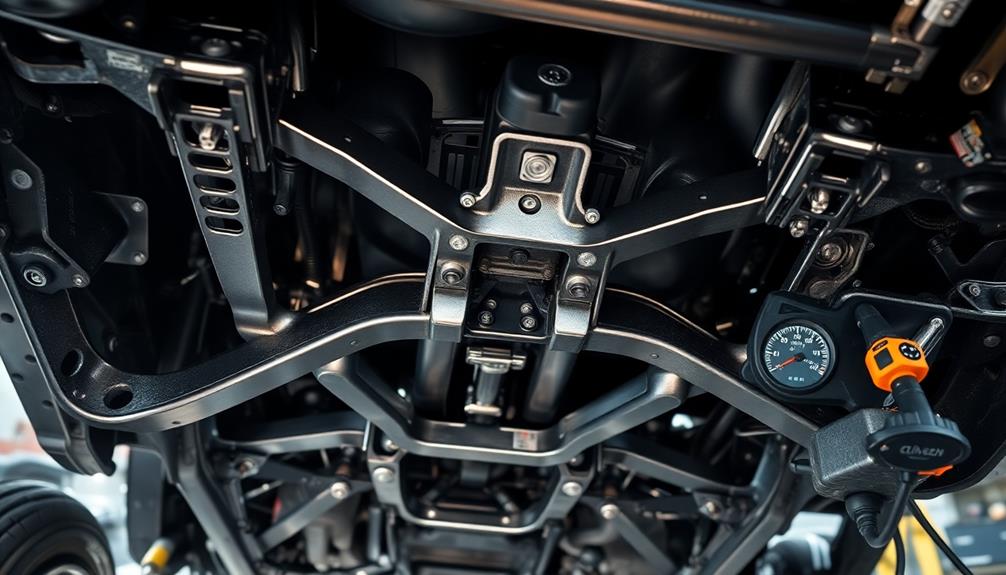
After confirming your vehicle undergoes a thorough professional inspection, the next step is to leverage advanced diagnostics for frame integrity. This process uses specialized equipment designed to evaluate the structural strength and alignment of your vehicle's frame, especially after a collision.
Standard inspections might miss hidden damage, but advanced diagnostics can detect issues like misalignments and structural warping that compromise your vehicle's safety systems.
Modern vehicles come equipped with over 100 sensors, all of which require meticulous calibration to confirm they function properly. If the frame integrity is off, it could lead to performance problems that affect the effectiveness of critical safety systems like airbags and stability control.
Professional technicians utilize advanced software to analyze data from these sensors, identifying potential frame issues that could compromise your driving experience and safety.
Regular diagnostic checks after any collision are essential. They help uncover hidden damages that mightn't be visible at first glance, ultimately improving driving stability and reducing the risk of accidents.
Repair Options for Frame Damage
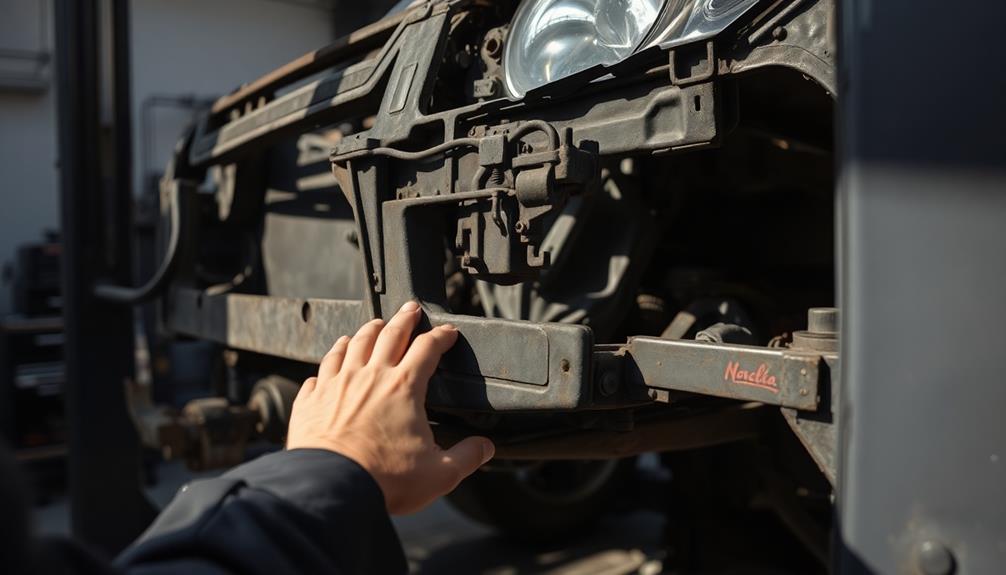
When it comes to addressing frame damage, you're often faced with multiple repair options that can restore your vehicle's structural integrity. The complexity of these repairs means you need to choose wisely to guarantee safety and performance.
- Thorough Assessments: Professional body shops will conduct detailed evaluations to uncover hidden damage.
- Specialized Hydraulic Tools: These are vital for straightening bent frames and guaranteeing proper alignment.
- Welding Techniques: Skilled technicians will use welding to replace or reinforce damaged components, restoring strength.
- Post-Repair Inspections: It's essential to have these inspections to calibrate advanced driver assistance systems (ADAS) and guarantee everything functions correctly.
Repairing frame damage isn't merely about aesthetics; it's about safety. Relying on professional body shops that employ skilled technicians guarantees that the repairs are done correctly.
They utilize advanced diagnostic equipment to identify issues that mightn't be immediately visible. If frame repairs are done improperly, it can lead to ongoing safety concerns and further damage.
Preventative Measures for Frame Safety
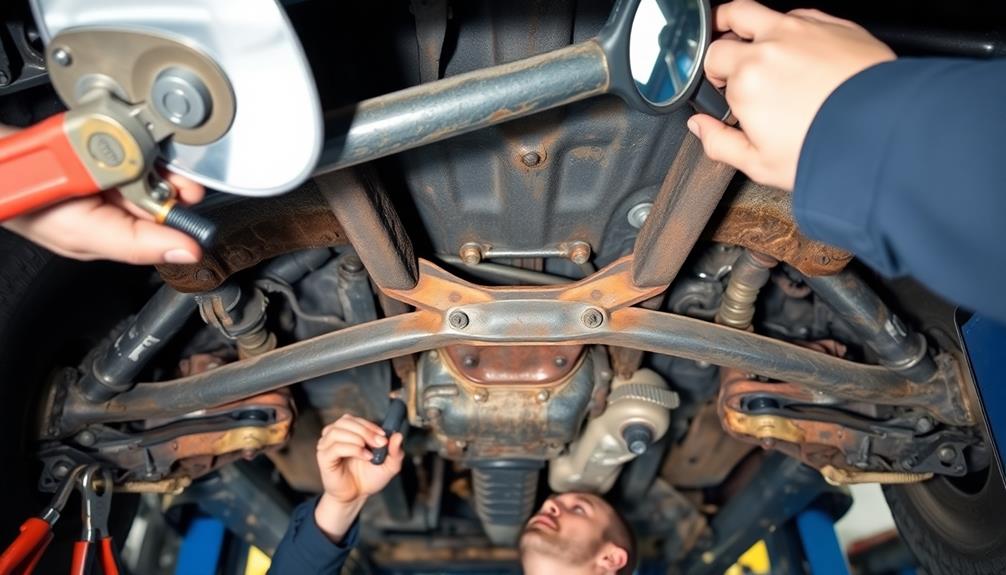
To keep your car's frame in top shape, regular inspections are essential.
Your driving habits also play a significant role; smooth driving can prevent unnecessary strain on the frame.
Regular Inspections Essential
Many drivers overlook the importance of regular inspections for their vehicle's frame, but doing so can be vital for safety. Even minor collisions can lead to hidden damages that compromise the structural integrity of your car.
To guarantee your vehicle remains safe and reliable, consider these key points:
- Regular inspections can identify frame damage before it becomes a major issue.
- Professionals can spot alignment problems and distortions that aren't visible to you.
- About 50% of post-collision vehicles hide frame damage that requires immediate attention.
- Routine checks can reveal signs of wear, such as uneven tire wear and handling difficulties.
Investing in regular vehicle maintenance not only enhances your safety on the road but also saves you from costly repairs down the line.
By staying proactive, you can catch potential structural issues early and avoid dangerous driving conditions. Make it a habit to schedule inspections to protect yourself and your loved ones.
Driving Habits Matter
Your driving habits greatly impact the safety and longevity of your car's frame. By being mindful of how you drive, you can greatly reduce the risk of frame damage.
First, regularly inspect your vehicle's suspension and vehicle alignment, as improper adjustments can lead to increased wear on critical components like tires and frames. Misalignments can lead to uneven tire wear and, over time, potential frame damage. Regular maintenance can enhance the efficiency of your vehicle's systems, including its frame integrity.
Be cautious when traversing road conditions; avoid driving over potholes or speed bumps at high speeds, as these can exert unnecessary stress on your vehicle's frame and suspension components. Keep a safe distance from curbs and roadside objects, since minor collisions can cause hidden frame damage that mightn't be immediately visible.
Additionally, limit the weight of loads in your vehicle. Excess weight can strain the frame, leading to sagging or warping.
Finally, schedule routine maintenance checks for your brakes to guarantee you can stop safely without compromising your frame's structural integrity during sudden stops.
The Role of Insurance in Repairs
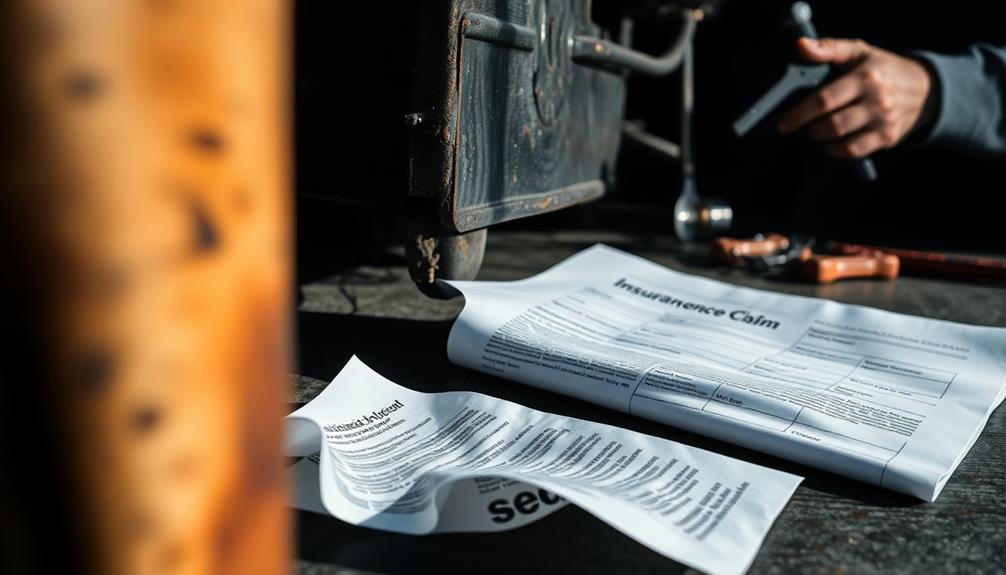
Insurance plays a vital role in the repair process after an accident, but it often prioritizes speed over thoroughness. This can lead to serious issues, especially when it comes to frame damage. You mightn't realize that hidden damages can lurk beneath the surface, waiting to compromise your vehicle's safety.
- Insurance companies might pressure auto body shops for quick turnarounds.
- Many insurance policies don't cover extensive diagnostic testing.
- Insurance assessments often miss significant frame integrity evaluations.
- Inconsistent repair quality can arise from varying protocols among insurers.
As a result, you could end up with inadequate repairs that overlook important issues. Insurance adjusters typically focus on visible damage, neglecting a thorough evaluation of hidden problems. This can leave you unaware of significant repairs needed for your vehicle's safety and performance.
To guarantee you're protected, it's vital to advocate for a detailed inspection at the auto body shop. Don't settle for quick fixes; prioritize repair quality to safeguard your vehicle and yourself on the road.
Maintaining Vehicle Frame Health

Maintaining your vehicle's frame health is vital for guaranteeing safety and longevity on the road. Regular inspections can help you catch issues like misalignment or rust before they escalate into significant problems. Proper maintenance of your vehicle's frame not only enhances its structural integrity but also improves your driving experience.
| Action | Benefits |
|---|---|
| Inspect frame regularly | Detect damage early |
| Maintain tire pressure | Prevent strain on the frame |
| Avoid large potholes | Mitigate frame damage |
| Service suspension system | Reduce frame stress |
Driving with proper alignment and well-maintained tires can prevent unnecessary wear on your vehicle's frame. If you notice signs of frame damage, such as pulling to one side or difficulty closing doors, it's important to address these issues promptly. Ignoring them can lead to costly repairs and compromise the vehicle's structure. By taking these proactive steps, you'll not only extend the life of your vehicle's frame but also guarantee safer travels for you and your passengers.
Frequently Asked Questions
Why Shouldn't You Buy a Car With Frame Damage?
You shouldn't buy a car with frame damage because it compromises safety, affects handling, leads to costly repairs, and considerably lowers resale value. You'll want a reliable vehicle, and frame damage can jeopardize that.
How Likely Is a Car Totaled if the Frame Is Bent?
If your car's frame is bent, it's likely to be considered totaled. Insurance companies often classify it in this manner when repair costs exceed 70-75% of its pre-accident value, jeopardizing safety and performance.
What Constitutes Frame Damage on a Car?
You might not realize it, but frame damage can silently threaten your safety. It includes bends, cracks, or misalignments that compromise your vehicle's structure, leading to poor handling and increased accident risk. Stay vigilant!
How Do You Tell if a Car Has a Bad Frame?
You can tell if a car has a bad frame by checking for cracks, rust, or bends. Look for uneven tire wear, difficulty closing doors, and listen for strange noises while driving. Get a professional inspection if needed.
Conclusion
Your car's frame is like the backbone of your vehicle, silently supporting everything as you hit the road. Ignoring hidden damage is like leaving a crack in that backbone; it can lead to serious issues down the line. Regular professional inspections are your safety net, catching problems before they spiral. By staying vigilant and addressing any signs of trouble, you're not just protecting your ride; you're ensuring every journey is as smooth as a well-oiled machine.

